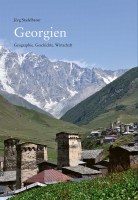Short Description
Georgia fascinates with its diversity: between the Black Sea coast and the Caucasus peaks, between rain-soaked woodlands and dry steppes, between lush cultivated vegetation and barren pastures, there are as many variations as there are between the lively capital Tbilisi and remote village settlements, between the winners of the post-Soviet transformation and impoverished small farmers, between dynamic tourist centres and the relics of defunct industrial enterprises. It is a country whose historical experiences include inner unity, but also disintegration into small territorial dominions and foreign rule, a country that proudly preserves its own traditions, but is also open to modern cultural trends. And a country that is still searching for its future between powerful individual personalities and parliamentary democracy.
Description
Georgia is a relatively small country in terms of area and population, but it attracts attention in many ways, as a brief look at just a few aspects reveals. The natural landscapes are extraordinarily diverse, ranging from the extremely rain-soaked Colchis lowlands to the almost desert-like Shiraki steppe, from ice-covered Caucasus peaks to flatlands and fertile basins. Earthquakes, avalanches and flash floods are natural risks that can lead to disasters with high losses. Today's territory, which currently has to live with the loss of sovereign control over Abkhazia and South Ossetia, looks back on a historical development that has seen periods of common statehood, but also periods of territorial fragmentation and burdensome foreign rule. Phases of cultural blossoming and economic prosperity were repeatedly contrasted with periods in which the country experienced decline and massive destruction of the cultural landscape. However, cultural anchors such as the Georgian language and script or the Georgians' affiliation to the independent Georgian Orthodox Church are a powerful defence against decline and destruction. Georgia is not just a country of Georgians: ethnic and linguistic minorities such as the Armenians in the south and the Azerbaijanis in the south-east demand recognition and co-determination in a society that clings to traditions but has suffered demographic losses. The secession of two territories, Abkhazia and South Ossetia, resulted in streams of refugees that have not yet been dealt with. The settlement system also has special features: It is characterised by the demographic and economic primacy of the capital Tbilisi, which has developed into a cosmopolitan centre since the middle of the 19th century. However, there are also extensive peripheral areas that even today seem to have a life of their own in seclusion. You have to look closely: Even in rural areas, architectural witnesses of the past such as churches and fortresses have been preserved. Four World Heritage Sites (the former capital Mtskheta, the medieval Gelati Monastery Academy near Kutaisi, the ensemble of high mountain settlements with defiant residential and fortified towers in Ushguli in Upper Svaneti and the natural area of the Colchis National Park) not only pose challenges in terms of preservation, but are also part of the potential for tourism, which is seen as one of the most important economic factors. Economically, the country has placed particular emphasis on expanding its transport and energy infrastructure in recent years, while industry is still suffering from the losses incurred during the dissolution of the Soviet Union. Agriculture, which was particularly emphasised in Soviet times due to the scarcity of subtropical suitable areas, but was developed in a one-sided manner, is only just beginning to regain its former importance. In addition to these very different facets of the country, there are also political challenges: Whether the path will lead to membership in the European Union or to greater dependence on Russia has not been decided, and the process of overcoming the consequences of Soviet-era upheavals and economic transformation is not yet complete. The book attempts to put these aspects into context, while at the same time using visual material to illustrate the fascinating diversity that visitors to the country can discover - as tourists as well as politicians or business professionals, or as guests of residents whose values include hospitality towards strangers.
Biographical Note
Jörg Stadelbauer, born in 1944, studied geography, history and Latin philology at the University of Freiburg. He was awarded his doctorate in 1972 with a study on railway construction in Turkmenistan and habilitated in 1979 with a thesis on the agricultural geography of South Caucasia. After being appointed to a temporary professorship and receiving a Heisenberg Fellowship from the German Research Foundation, he was appointed full professor at Mainz in 1987. In 1991, he accepted a full professorship for cultural geography and regional studies at the University of Freiburg. He took statutory retirement in 2009. He held a deputy professorship in Tübingen and guest professorships in Basel, Berlin (Humboldt University), Bern and Moscow. His scientific work has focussed on agricultural, urban, transport and political geography of the Soviet Union and its successor states, as well as on the historical geography and regional studies of south-western Germany and eastern France.




 Preface
Preface

 Neuerscheinungen 2023/2024
Neuerscheinungen 2023/2024
 Gesamtverzeichnis 2023/2024
Gesamtverzeichnis 2023/2024
 Katalog Oriental Studies & Linguistics
Katalog Oriental Studies & Linguistics
 Mittelalter
Mittelalter
 Deutsche Inschriften
Deutsche Inschriften
 Musiktherapie
Musiktherapie
 Literaturen im Kontext
Literaturen im Kontext